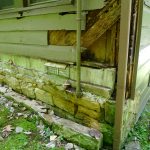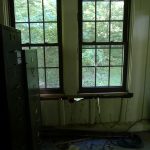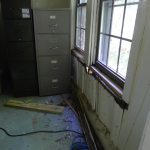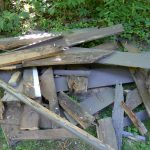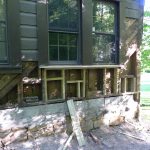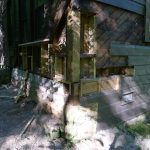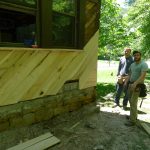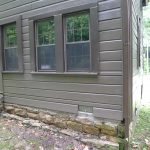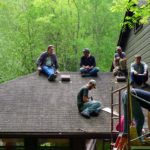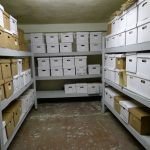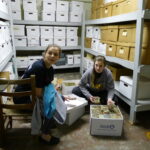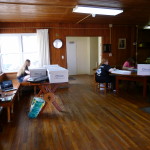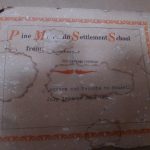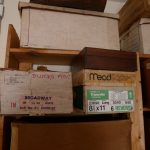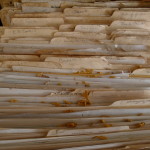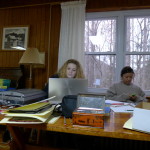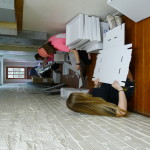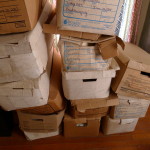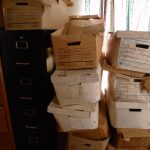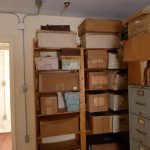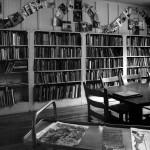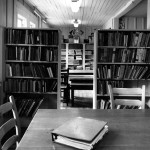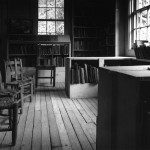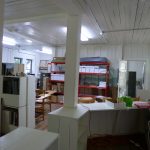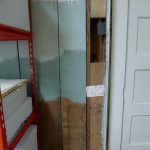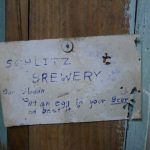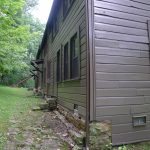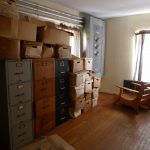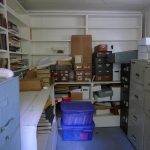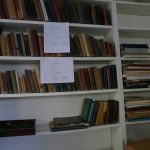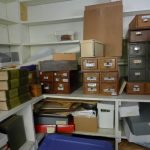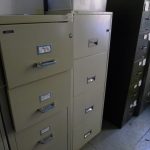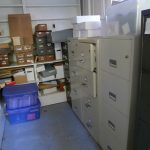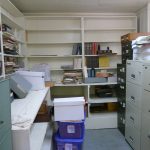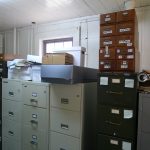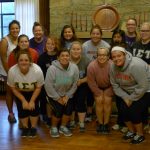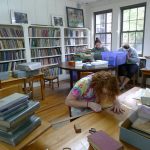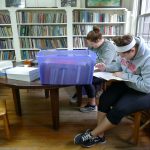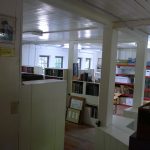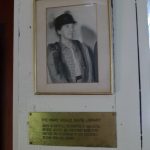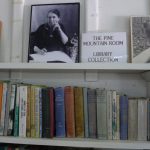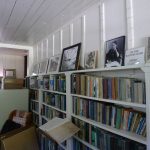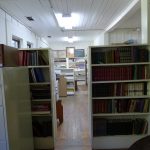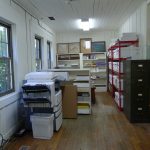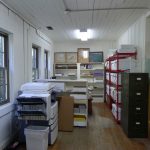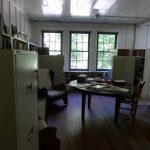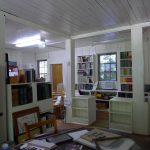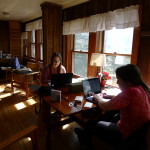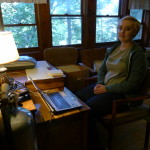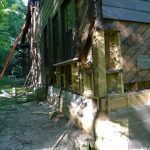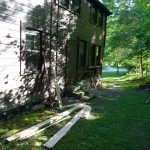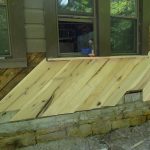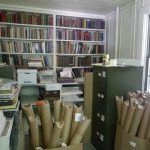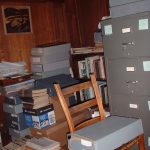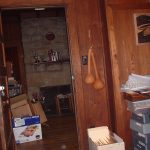Pine Mountain Settlement School
Series 00: Archive
Turns a Corner

The PMSS Library (Boys House), c. 2017. [P1150810_smaller.jpg]
ARCHIVE 2017 PMSS Archive Turns a Corner
TAGS: PMSS Archive Turns a Corner, PMSS Collections, Boys House, National Historic Landmark, Appalachian Regional Commission (ARC) Grant,West Wind, Office, Berea College SIA microform project, Settlement Institutions of Appalachia (SIA), records disposition, record management, Appalachian Challenge Academy, community library, children’s library, Mary Rogers, carpenters, Mary Gould Davis, Pine Mountain Room, HVAC systems, Geoff Marietta, Nancy Adams, donors, Creech Family, Lewis Family, Nolan Family, Board of Trustees, Karen Hudson, Anna Cummins Smith, Cathi and Carolyn Castle, volunteers
The archive at PMSS has turned a corner.
When the corner of Boys House, one of the oldest buildings on the Pine Mountain Settlement School campus, began to melt into the woods, it was clear that intervention was needed. The northwest corner of the building was where the Pine Mountain Archive had come to rest after several wanderings from building to building over many years.
At the building corner, paper, wood, and trees had begun to mingle and a black ring-necked snake had taken up residence in one wall of the archive. It was evident that the archive and the building could not continue their return to pulp and unwelcome residents. As the self-assigned resident archivist, the slithery snake kept the mice at bay, but he created a certain uncertainty for the two-legged patrons. Surely, he had no patience with metadata even though he had a long tail. (That last sentence is for archivists.)
GALLERY I: Pine Mountain Settlement School Archive Turns a Corner
- 2017 Exterior damage to Northwest corner of Boys House.
- 2017 Repair of interior damage in small annex behind main archive room. Boys House. Archive/Library room.
- 2017 Repair of interior damage in small annex behind main archive room. Boys House. Archive/Library room.
- 2017 Exterior damage to Northwest corner of Boys House damaged wood.
- 2017 Exterior damage repair to Northwest corner of Boys House.
- 2017 Exterior damage to Northwest corner of Boys House.
- 2017 Exterior damage to Northwest corner of Boys House under repair by T.J. and Mark.
- July 2017 New siding and corner repaired and painted. Boys House.
- 2017 Boys House repair and Bob Yapp workshop lesson in proper flashing. Photo by HHW. [P1130848.jpg]
Pine Mountain Settlement School has over 24 buildings on the campus site. Unlike archives that situate themselves within buildings, the archive at Pine Mountain is comprehensive. The buildings and the physical site are part of the archive of the institution. Designated a National Historic Landmark in 12/04/1991, the site requires that as much attention be given to the built environment of the School as to its more “hidden” documentary history — the so-called, standard archive. Maintaining the comprehensive landmark archive at Pine Mountain is a tall order.
In 2017 Pine Mountain was awarded an Appalachian Regional Commission (ARC) Grant that prepared the way to make major improvements in three key buildings and to the physical storage of materials within those buildings. Including the funding match, the grant provides over $400,000 to address a myriad of physical ills in the built environment at the School. Two buildings scheduled for restoration, Boys House (Library) and West Wind, currently hold the bulk of the standard archival materials at the School. These materials — documents, photographs, media, and realia (objects) are collections in various forms of distress from years of benign neglect, improper storage, and various uninformed but caring attempts to give selective collections order and care.
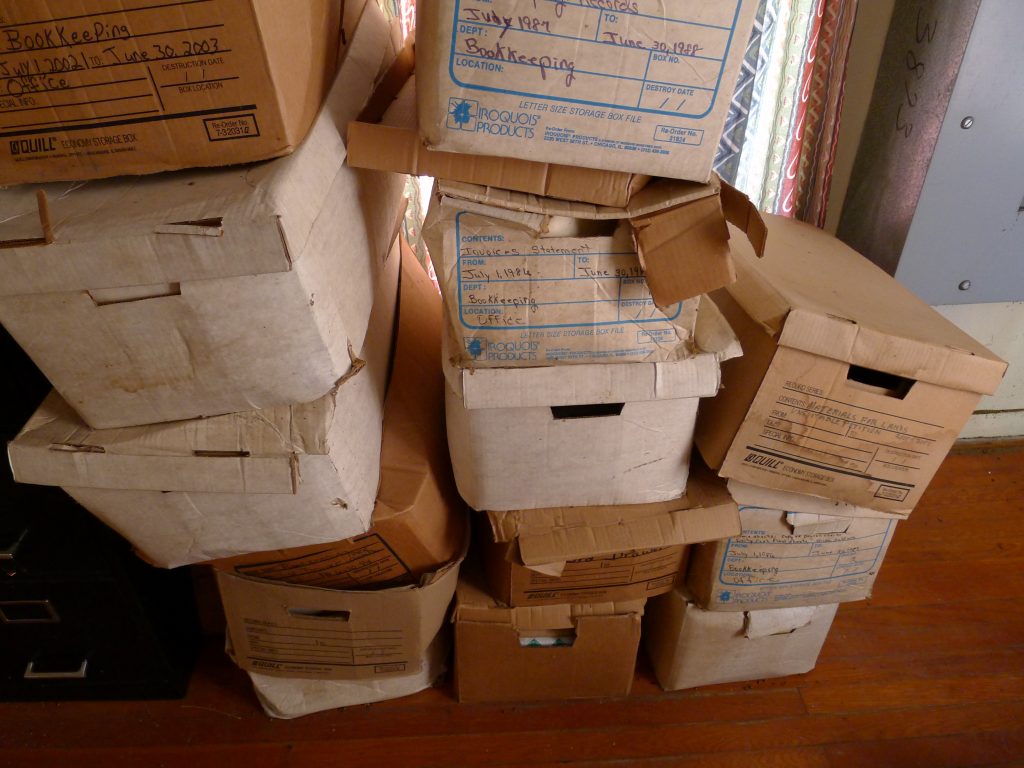
West Wind Records storage before clean.
For a time collections that were frequently used, such as photographic collections, were housed in the main Office building where the materials shared space with interns, staff, and were sometimes mixed with records of the operation of various institutional programs, such as the Environmental Education program. The Office was air-conditioned but it was a vulnerable collection location. The best that could be said about the Office environment was that the collections housed there were convenient resources to the administrative staff. While most of the collections in the Office were housed in the air-conditoned space, the attic contained records going back to the School’s beginnings in 1913. Attic storage temperatures reached well over 110 degrees most summers and high acid paper rapidly turned to confetti in many of the metal file cabinets. The Office storage was convenient but also had a “brittle” paper problem.
At West Wind, the conditions were neither air-conditioned nor convenient. The rooms that housed the collections were either insect-laden or too moist for long-term storage. For years the financial records were piled high in a room that housed the electrical circuit box for the building and that was often accessed as electrical problems needed to be addressed. The boxes of office records, largely financial, eventually collapsed under their own weight. Unprocessed records of previous Directors were also stacked high or crammed into filing cabinets or mixed with the financial records. The processed records that were part of the Berea College SIA microform project of 1983 were also housed in the same room and were in better condition, but housed in non-archival cartons that were shared with annual lady-bugs.

Fairmont University. Alpha Sigma Tau service project in West Wind.
The Archives have greatly benefitted from the help of student labor. in a series of visits, girls from various Alpha Sigma Tau sorority chapters, cleaned, re-housed, labeled and re-foldered collections. Alpha Sigma Tau Sorority students, from Virginia, Michigan, Maryland and other states, came to the campus as part of their service projects. Over the course of several years, the girls gave hours of their time to a variety of critical maintenance and inventory tasks. Their generous support gave the collections the vital processing that allowed the archive to bounce back from the brink of despair (or was it the archivist’s brink of despair?).
New boxes were ordered, assembled by the sorority sisters and then the newly housed collections were moved across the hallway to a cooler room with racks that could accommodate both the large (54 cartons) SIA (Settlement Institutions of Appalachia) microfilmed materials and the newly re-boxed Director’s files (50+ cartons).
- West Wind. New storage space for Berea microfilmed archives.
- Fairmont University. Alpha Sigma Tau service project in West Wind.
- West Wind. Fairmont University. Alpha Sigma Tau service project in West Wind.
- West Wind Records storage before clean.
- West Wind Records storage before clean.
- West Wind Records storage before clean.
- Archival papers project. Fairmont University. Alpha Sigma Tau service project in West Wind.
- James Madison University crew hard at work on archives at West Wind. Scanning and data entry. [P1060793.jpg]
- Fairmont University. Alpha Sigma Tau service project in West Wind.
The financial records, collapsing under their own weight, were re-boxed and ordered in their original location at West Wind. Given some storage order in the hot but dry west-facing room where they had been placed over the years, the full disposition of the records were put on hold as their requirements were too extensive and would have to wait for another time. Disposition activity requires that each individual record must be handled and evaluated for disposal according to a disposition schedule. This had only rarely been followed by over-worked staff.
- West Wind Records storage before clean. Fairmont University. Alpha Sigma Tau service project in West Wind.
- West Wind Records storage before clean.
- West Wind Records storage before clean.
In the Office building, the storage and preservation problems were even more challenging. Stored in a small cramped space that also housed two staff members, there were 6 file cabinets (4 fire-proof) that were slowly re-shaping the flooring with their weight. A small closet housed music and dance collections that are probably a gold-mine for folklorists. On top of file cabinets were boxes of textiles, framed pictures and over-sized objects. In the file cabinets were a myriad of duplicates of material held at West Wind. Every cranny and nook was filled with a combination of precious and duplicate collections. There was no security. The small office had constant traffic in and out.
THE MOVE TO THE LIBRARY (BOY’S HOUSE)
With the help of the Appalachian Challenge Academy from Harlan, the collections were removed from the Office to Boys House Library. The Appalachian Challenge Academy, part of a national program to assist at-risk youth, between ages 16 – 18, who have either dropped out of traditional school setting or are at risk of dropping out, for a time worked weekly at Pine Mountain assisting the School with maintenance projects. The eager and cooperative young men and women were a critical assistance in making the move to Boys House happen.
The collections in the Office were boxed and file-cabinets were pulled and removed to a small secure room at Boys House — the ring-neck snake room; the deteriorating northwest corner of Boys House — but not for long! Work on the building soon commenced and the corner room was the first order of repair. The collections were moved again to make way for repairs.
Repair and re-organization also soon began in the large library room that would eventually house the bulk of the archive collections from West Wind and the Office. Old library shelving was removed (too narrow for carton storage) and tall, red metal storage racks added along the walls of the room near the ring-neck snake room. Some old shelving was left intact to house the large book collections from the old library. The circulation shelves were removed and the full space opened up and re-painted.
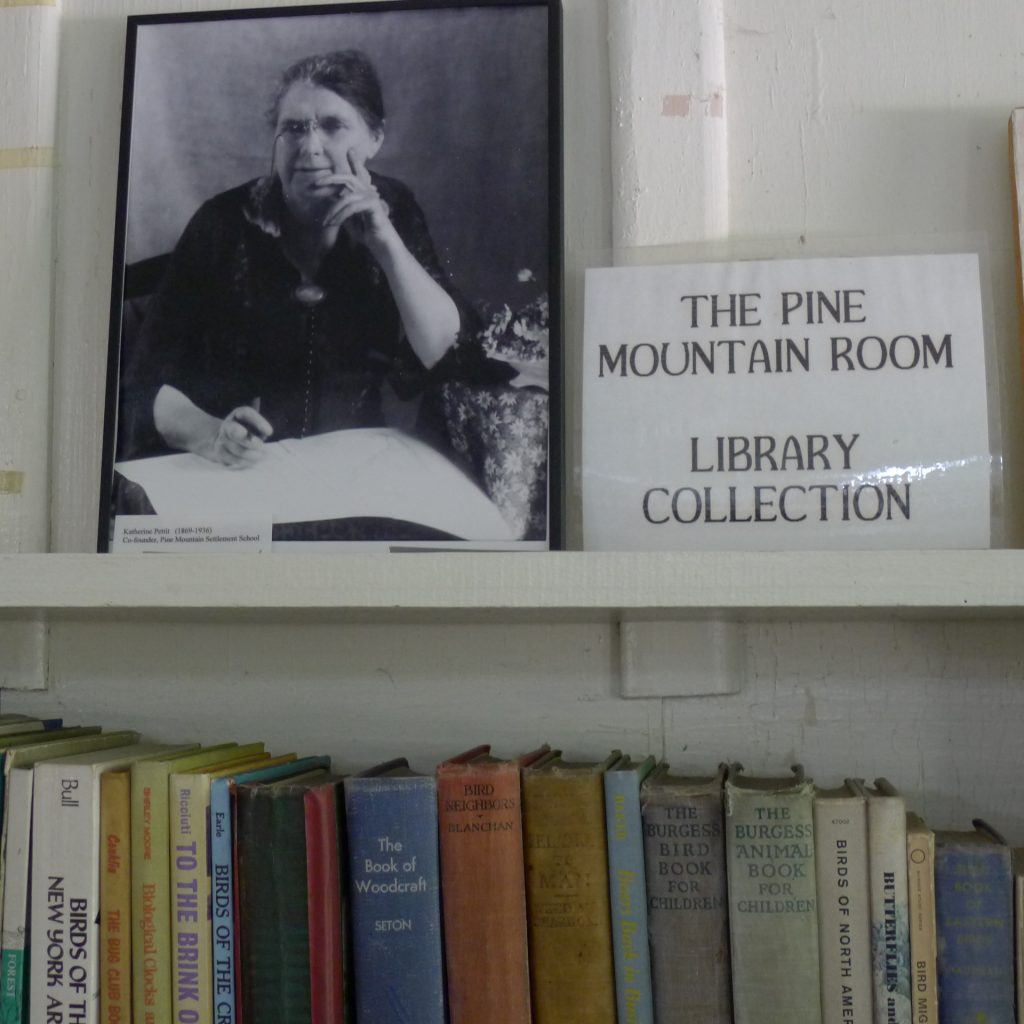
While the early Library created by Mary Rogers was in operation, an adjacent Pine Mountain Room, held archival records and photographs. These were the materials moved to the Office in 2000. We can not help but be pleased to see those materials coming back to Boys House.
And, while some of the shelving was removed, much of Mary Rogers’ work to create the community library remained in the room. The pictures below shows the community library in the 1960s.
- Boys House. Interior view of library, c. 1960s.[II_08_boys_house_313c.jpg]
- Boys House. Interior view of library.[II_08_boys_house_315.jpg]
- Boys House. Interior view of library. [II_08_boys_house_314.jpg]
As the old library shelves were pulled from the walls to make room for wider shelving to accommodate archival boxes, a small SURPRISE note was found thumb-tacked to the joist of a wall. It read
“SCHLITZ BREWERY” Put an egg in your beer and beat it.”
- Boys House. Archive/Library room.
- Library. A surprise hidden in the woodwork. Discovered on the remodel. Boys House. Archive/Library room.
- Library. A surprise hidden in the woodwork. “Put an egg in your beer and beat it.” Discovered on the remodel. Boys House. Archive/Library room.
Some prior carpenter must have had a hang-over! Not so the new PMSS skilled carpenters on the shelving, led by Charley Crain, Maintenance Supervisor. New shelving went in and the back wall was re-painted and the open and light-filled room began to sparkle. A copier was added and a friendly round table for meetings and users was placed in the reading room area. Comfortable Pine Mountain chairs were spread around the room. A niche was created for working on the archive collections and for scanning and internet access was checked and connected.
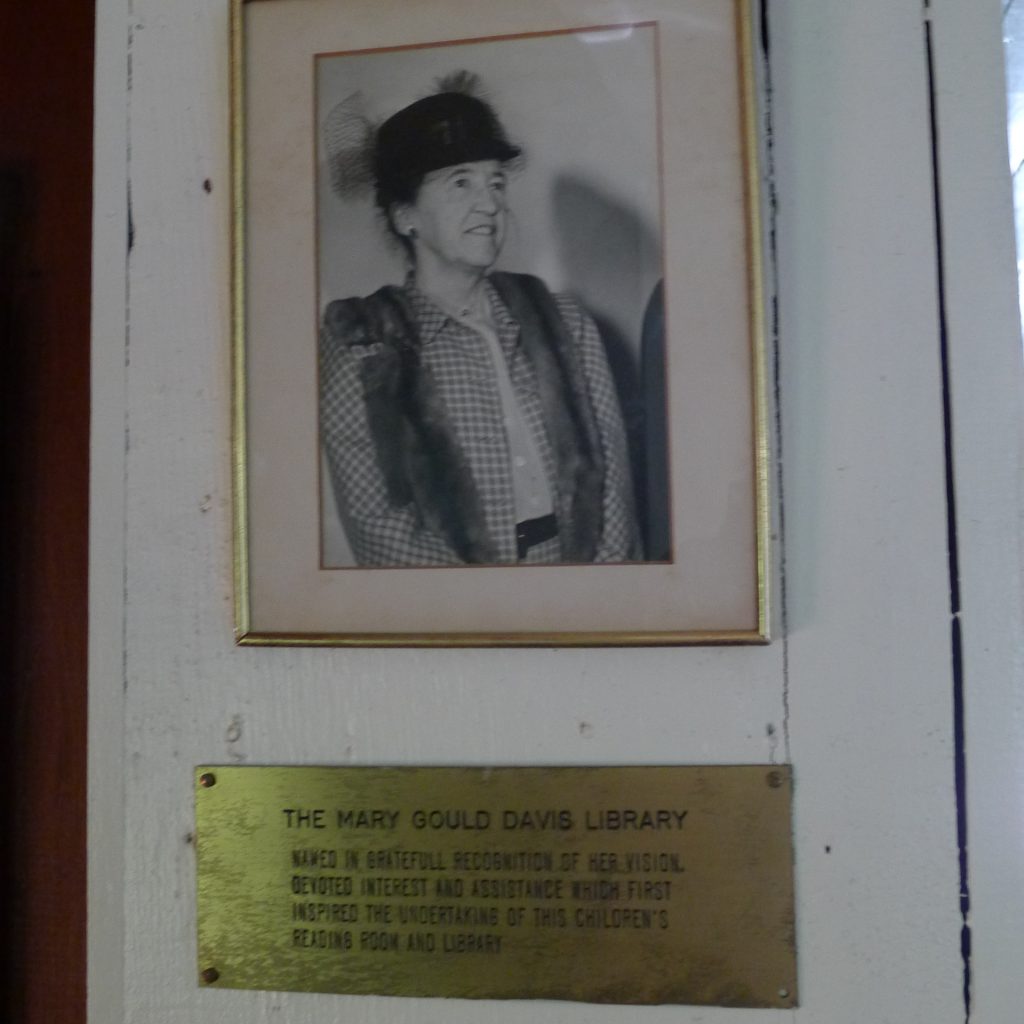
Mary Gould Davis. The donor of funds for first library. Boys House. Archive/Library room.
Building on the work first supported by Mary Gould Davis, the new library and archive at Boys House remembered the vision of Mrs. Davis. It was her support and the hard work of Mary Rogers that brought about the first children’s library and location of the Pine Mountain Room where the first archival materials were housed. But, it was Mary Gould Davis whose “…devoted interest and assistance …” first inspired the undertaking of the children’s reading room and library.
As we move forward, the final steps of bringing the West Wind materials to Boys House will see another surge of construction to secure the collections and add a new HVAC system. The collections from West Wind will fill the new shelving racks. The small annex room — the corner room — will provide additional security and will house selected and unaccessioned collections. Extra shoring-up of the floors in the annex has been completed to accommodate the weight-load of four fire-proof cabinets. We have great expectations for the continued growth of the library and archive.
For those volunteers who suffered some abysmal working conditions, we often found in the early archive (you know who you are), the new HVAC system will come with the next wave of remodeling. A temporary air-conditioning unit now currently off-sets global warming and temporarily keeps the archive space cool for researchers and volunteers. [The new HVAC system arrived in 2021 !]
VOLUNTEERS
Speaking of volunteers — there have been many. Helen Wykle and Ann Angel Eberhardt who have worked for nearly 18 years to digitize and bring attention to the collections are enormously grateful for the help we have received through the years. To Nancy Adams, former Director, for her interest and careful preservation of film, photographic and textile collections, we continue to be thankful. The staff at the School have been some of the best supporters. We thank maintenance and housekeeping and the programming staff, especially Judy Lewis, who keeps us laughing and who knows where all the history is hiding. And all the other staff for all they do to keep snakes, mice, and dust out of the collections and visitors interested in what we try to do there.
When Ann and Helen and volunteers came for long stays or short ones to work on the collections over the years, the staff have fed us, inspired us, kept us clean and secure, and continue to inform us of institutional history. As access to the archival holdings become more unrestricted, it is hoped that programming will also improve, bolstered by local resources that will be woven more intimately into the institutional and community narrative and the lives of the people it chronicles.
IMPORTANT VISITORS
Of special mention is the work completed by Scott Husby and Tracey Cullen, two natives of Minnesota. They share our enthusiasm for the artist John A. Spelman III whose block prints are well represented at Pine Mountain when he taught for a time in the 1930s. Scott Husby was formerly the conservator for Rare Books and Special Collections at Princeton University and visiting conservator at the Beinecke Library at Yale where he directed the conservation of rare fifteenth-century incunabula. His skills are as rare as the special collections he handled. He came to Pine Mountain to review our Spelman holdings after discovering Spelman’s work in Minnesota.
After a review of over 100 blocks and many prints and paintings by the artist, Scott and his partner, writer Tracey Cullen took on the task of housing the print blocks of Spelman. They recommended hand-made boxes sized for each block item. The two spent hours measuring and evaluating the Spelman block collection. A few months later they sent us an extraordinary assortment of boxes hand constructed by Scott and mapped to each item in the block collection. The boxes, exquisite in their sizing and careful construction, will give the Spelman blocks a long life in our collections.
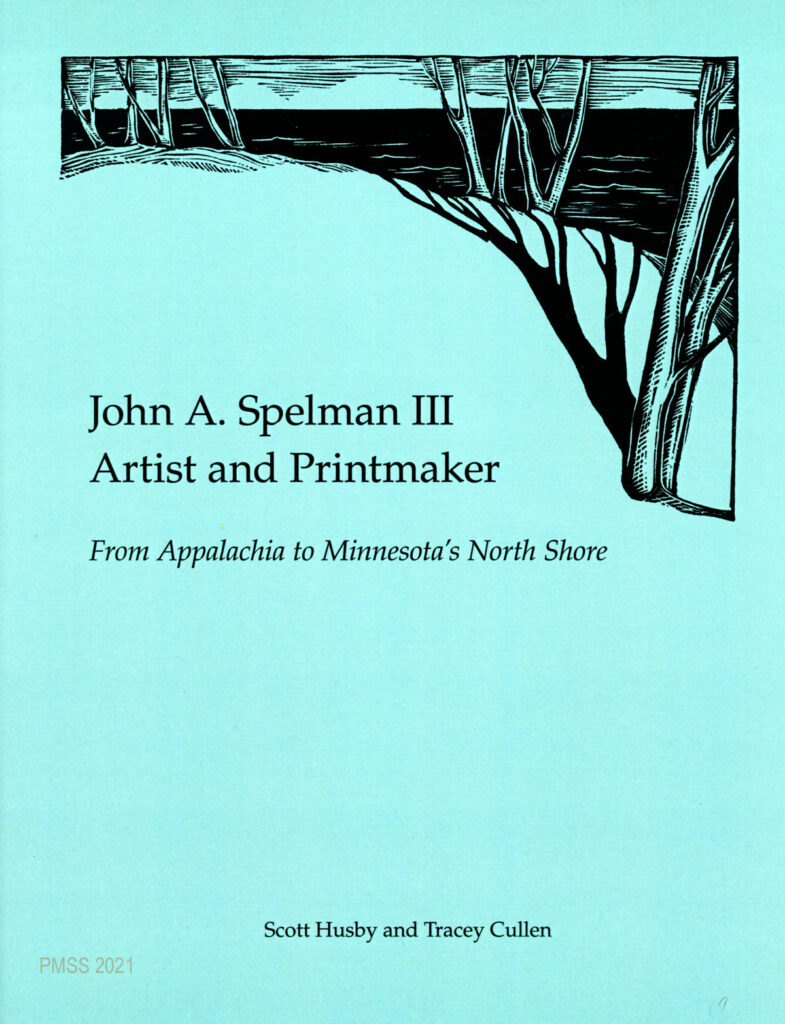
Further, we look forward to an upcoming publication that Scott and Tracey will soon publish [NOW PUBLISHED! SEE ABOVE] on Spelman’s work. Their publication will accompany an exhibit of Spelman’s work in Grand Marais, Minnesota that will focus on the artist’s print work related to the Grand Marais and Pine Mountain locations. Their interest and commitment of time and assistance in preserving Spelman’s work is deeply appreciated. **[The publication of Spelman’s work in Kentucky and in Minnesota has now (2021) been published and may be purchased. See: Scott Husby, Tracey Cullen. John A. Spelman III, Artist and Printmaker: From Appalachia to Minnesota’s North Shore, Cook County Historical Society, 2021. ISBN 057889761X, 9780578897615.]
Spelman left his own book of the Kentucky experience that he called At Home In The Hills: A Cross Section of Harlan County, Kentucky.(1937) Now, quite rare, his original book is difficult to find but if the reader locates a copy they will be rewarded with more of this extraordinary print-maker’s work. Thank you Scott and Tracey for your persistence in bringing your recent documentation of Spelman in Minnesota together with his Kentucky work and introducing more admiring folk to Spelman’s art. And, even more, thank you again, Scott, for your dedicated and meticulous work on boxes to preserve Spelman’s original blocks.
DONORS
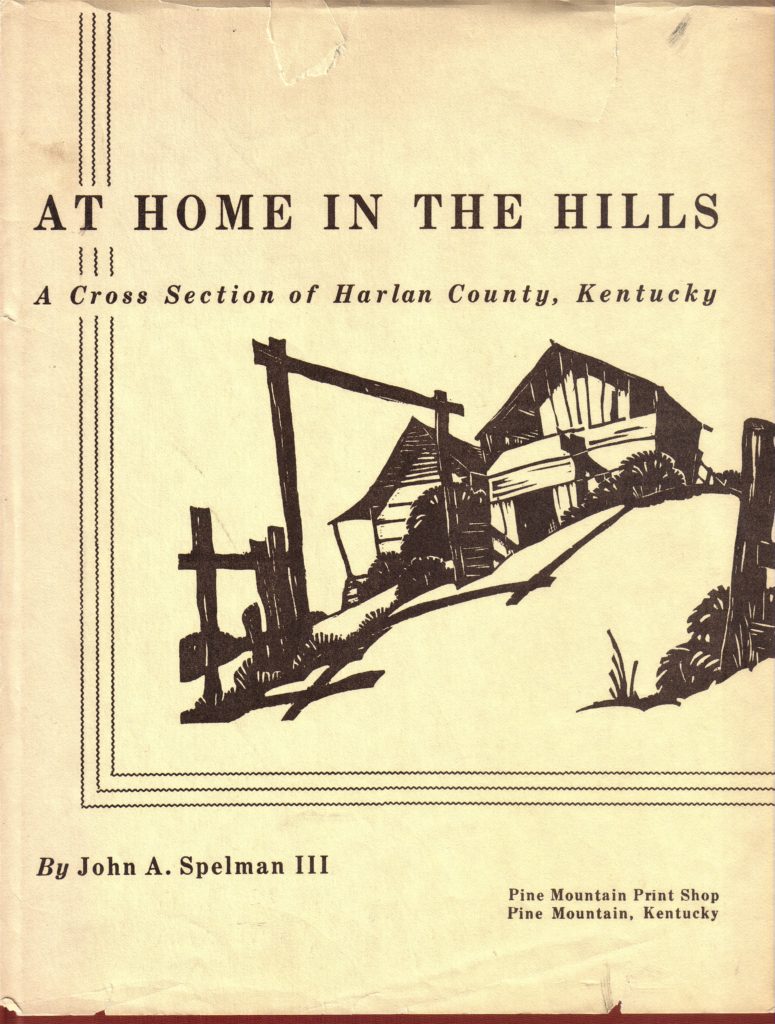
“At Home in the Hills” book jacket, front. [pmss_archives_spelman_bk_cover.jpg]
Thank you, as well, to all the users who have helped us to bring attention to this Appalachian archive treasure trove, and have kept us honest in our narrative. James Greene III, comes especially to mind. Special thanks also go to the support received from the Board of Trustees, especially Karen Hudson, a historic preservationist, for the deep dive into the architectural history of the School and for special digital scanning of the large-scale architectural drawings that are so difficult to preserve. Anna Cummins Smith, you are special for the many, many hours you have given the collections and for tolerating the never-ending chatter of Ann and myself. You just keep on keeping on. I still cannot apologize enough to the Castle sisters, Cathi and Carolyn, who worked under “Deplorable Working Conditions,” — so their protest sign read. While freezing to death they brought order out of the Community School files last November (2017). And, they still want to come back!
We welcome volunteers. If you are interested in giving time to the archive please contact:
Office Assistant (606) 558-3571 at the PMSS Office or *hhwykle@gmail.com*
We would like to talk to you about your interest and arrange time for you to contribute hours on site. Supervised volunteer work generally comes with free lodging and meals for 8 hours each day of service. If you cannot commit to hours on site we are always happy to have your assistance with crowdsourcing of transcription of our documents or monetary donations to the School’s Archive project.
GALLERY II: Pine Mountain Settlement School Archive Turns a Corner
- Exterior, West Wind.
- West Wind financial and office Records after clean. [P1060525.jpg]
- The archive begins its move from the Office to Boys House.
- The new Library and Archive space at Boys House —complete with its own Blue Fairy.
- The new Library and Archive space at Boys House —complete with its own Blue Fairy.
- Boys House. The ring-neck snake room begins to accept the Office archive.
- PMSS Collections. The Archive’s corner room shelves filled with Pettit and de Long book collections. [P1110196.jpg]
- The corner room beginning to fill with photograph albums, multimedia, catalog files, etc.
- Boys House. The fire-proof cabinets are moved into the small storage room. [P1110200]
- Boys House. In the Annex room. The fire-proof cabinets are moved into the small storage room.
- Boys House. The Annex room begins to fill as collections are removed from Office into the small storage room.
- Boys House. The room begins to fill as collections are removed from Office into the small storage room.
- Alpha Sigma Tau Sorority volunteers
- Library. View out the window to playground
- Alpha Sigma Tau Sorority volunteers
- Alpha Sigma Tau Sorority volunteers
- Alpha Sigma Tau Sorority volunteers
- Alpha Sigma Tau Sorority volunteers
- Library. A surprise hidden in the woodwork. Discovered on the remodel. Boys House. Archive/Library room.
- Library. A surprise hidden in the woodwork. “Put an egg in your beer and beat it.” Discovered on the remodel. Boys House. Archive/Library room.
- View of Archival Collections space. Boys House. Archive/Library room.
- Mary Gould Davis. The donor of funds for first library. Boys House. Archive/Library room.
- The Pine Mountain Room, Library Collection.Boys House. Archive/Library room.
- Book collections. Archive/Library room located in Boys House.. [P1140225.jpg]
- View from reading room toward processing/work/collections area.Boys House. Archive/Library room.
- Work area and photocopier Boys House. Archive/Library room.
- Work area and photocopier. Boys House. Archive/Library room.
- Temporary placement of three large fire-proof cabinets in reading room. Boys House. Archive/Library room.
- Boys House. Archive/Library room.
- View of north window with air-conditioner (temporary until full HVAC). Boys House. Archive/Library room.
- 2017 Repair of interior damage in small annex behind main archive room. Boys House. Archive/Library room.
- 2017 Repair of interior damage in small annex behind main archive room. Boys House. Archive/Library room.
- Grand Valley University, Michigan, Alpha Sigma Tau volunteers. March 2-4, 2015. At work in Hill House on the PMSS archive.
- Anna Cummins Smith
- Anna Cummins Smith, community volunteer Librarian who assisted in preparation and follow-up for the two Alpha Sigma Tau work on the PMSS Collections. It’s dinner time at Hill House, 2015. Photo by AAE.
- Alpha Sigma Tau. (Alpha Chapter) Eastern Michigan University, Ypsilanti. Sorority sister who was a dedicated scanner. [P1100114.jpg]
- 2017 Exterior damage to Northwest corner of Boys House.
- 2017 Exterior damage repair to Northwest corner of Boys House.
- 2017 Exterior damage repair to Northwest corner of Boys House.
- 2017 Exterior damage to Northwest corner of Boys House.
- 2017 Exterior damage repair to Northwest corner of Boys House.
- Archival collections, moving. Boys House. Archive/Library room.
- Archival housing at Office
- Archival housing at Office
- Archival housing at Office
- Archival housing at Office
- Archival housing at Office
- Archival housing at Office

